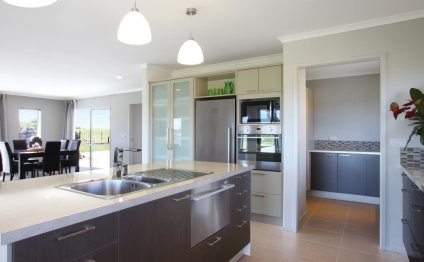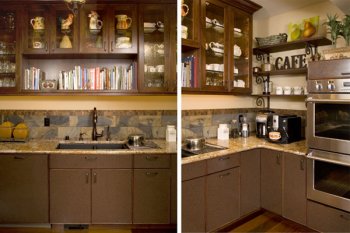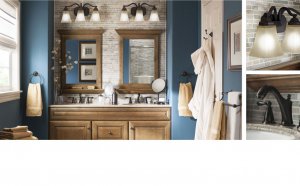
Kitchen scullery Design
 But all that openness has been around for awhile, and for some folks the pendulum is now swinging back the other way.
But all that openness has been around for awhile, and for some folks the pendulum is now swinging back the other way.
Which is better? We’ve got the answer.
Related: Timeless Kitchens
Opening Arguments: The Open Kitchen
The idea of the open kitchen has been around since the 1990s and continues to be popular.
For example, in 2006 the American Institute of Architects (AIA) reported that “the integration of kitchens with informal living space (great rooms) remains a popular design.” The report added that more than half of design firms were experiencing increased interest in open space floor plans.
Fast-forward to a 2013, and AIA reports that all is well with the open kitchen: “Integrating family space with kitchens remains a very popular design option.”
What’s good about it? Advocates say their open kitchen:
- Keeps the family in touch by integrating meal prep with nearby activities, such as watching TV in the family room.
- Invites guests into the hub of the home, and facilitates conversation between guests and home cooks.
- Adds a sense of volume, especially in modestly sized homes.
Closing Arguments: The Closed Kitchen
“Closed” doesn’t mean claustrophobic. It means that kitchen access is limited to doorways, and that food prep and cleanup is hidden from view.
The most-popular reasons for having a closed kitchen include:
- More walls mean more cabinet storage, countertop work space, and room for appliances.
- Guests aren’t inclined to enter the kitchen and disturb the cook.
- Cooking odors are confined to the kitchen.
- The dining experience is more formal.
A Houzz commenter posts: “I prefer a closed off kitchen. When I cook I like privacy and silence. I often make things I have never made before when entertaining and need to be able to concentrate without questions or recommendations on how to do something differently.”
The Verdict: It’s the Scullery for You
“There’s a middle ground that’s becoming much more common, ” says Seattle kitchen designer Richard Landon, who likes to incorporate small prep kitchens or “sculleries” (as seen in the right side of the image above) that are walled off from main kitchens.
The idea, says Landon, originates in England, where sculleries were used for washing dishes and laundry, and for messy tasks, such as plucking chickens. Landon puts cleanup sinks, wall ovens, and dishwashers in his sculleries to keep clutter concealed.
Image: Richard Landon, NWSID, CMKBD
Meanwhile, he might put a cooktop and small bar sink in the open kitchen area to maintain a communal atmosphere.
“The kitchen is still the hub of family life, ” says Landon. “To me, a completely closed-off kitchen is at the far end of the spectrum.”
“You can do a lot in just 40 square feet, ” says Landon.
Get the Best of Both Worlds
Ideally, the best kitchen is a compromise: One that closes off the smells and mess, and yet doesn’t isolate the cook. Here’s how you can achieve that ideal mix.
Adding a pass-through window is a simple way to connect spaces without tearing out the walls of a closed-off kitchen.
Speaking of walls, taking out a non-bearing wall (cheaper and safer than a bearing wall for sure!) and replacing it with a half wall or peninsula is a somewhat expensive but most-obvious way to open up a closed kitchen. Good idea: Hire an architect or designer who can make sure the end result is a happy one.
Folding or pocket doors separate the kitchen from living areas by opening up when you want continuous flow and closing when you don’t. (Swinging French doors are pretty but take up too much space.) Sizes for pocket and sliding doors range from small (24 inches wide) to huge (16 feet or more). Use a clear or translucent glass door to keep light flowing.
A peninsula separates your kitchen from nearby living spaces. Include upper cabinets with glass fronts that establish privacy yet let light through.
Add a raised bar/eating counter to your island. Face the raised part toward your living areas so it blocks views of food prep areas. Kitchen countertops are typically 36 inches high; raised counters are 40 to 46 inches high.
A half wall 40 to 50 inches tall built between the kitchen and living area establishes physical and visual boundaries for your kitchen. Top the wall with a glass partition to reduce noise, yet allow light transmission.
or downdraft unit ensures your cooking area is properly vented to the outside so that odors are kept out of living and dining rooms.
Quality, sound-dampening appliances cost more but won’t interfere with nearby conversations.
An extra-large, extra-deep sink is a godsend for quickly swallowing messy dishes and pans. Ditto for a second dishwasher.
RELATED VIDEO



Share this Post
Related posts
Bathroom countertops Design
Get exactly what you want for your bathroom using our vanity top design wizard. We fabricate all of our vanity tops to order…
Read MoreLowes Bathroom Design Ideas
Shop Bath Collections at Lowe s to Create Your Dream Bathroom The inspiration experts at Lowe s know that your bathroom is…
Read More











